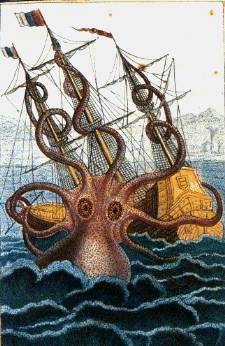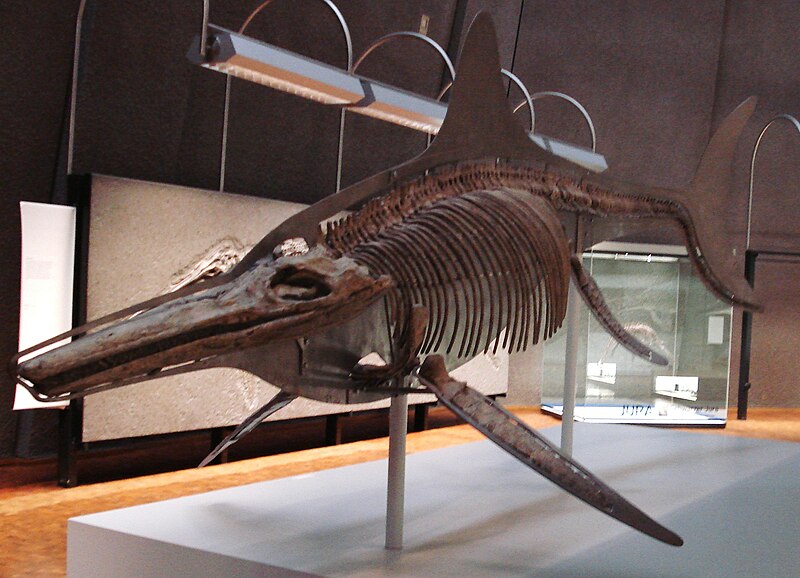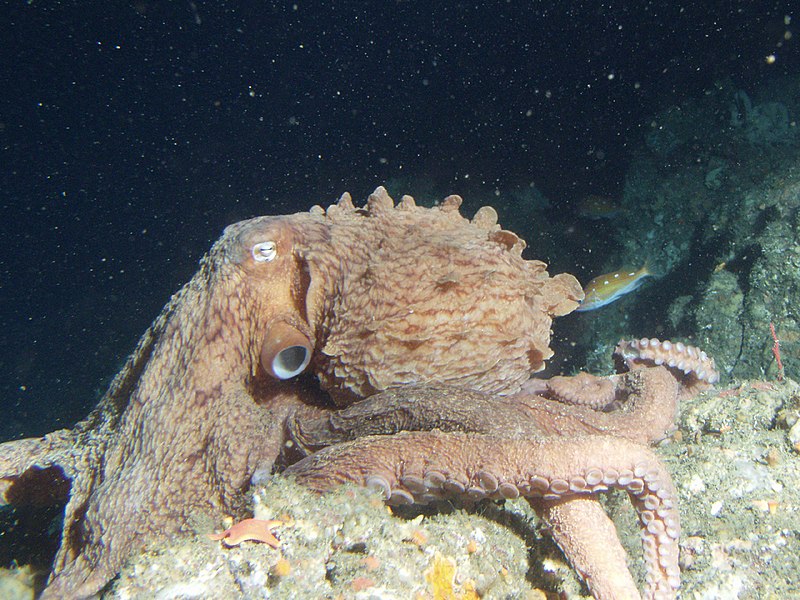 Hello, Frank Indiviglio here. For centuries, sailors have repeated the legend of the Kraken, an enormous octopus-like creature said to attack ships (please see artist’s recreation). Today we believe that such tales were based on actual sightings of real-life Giant Squids, which may exceed 60 feet in length (frightening, but never observed attacking ships…as far as we know!). However, recently uncovered fossil evidence suggests that a giant octopus actually may have haunted the Triassic seas – and that it was able to capture bus-sized marine reptiles known as Ichthyosaurs!
Hello, Frank Indiviglio here. For centuries, sailors have repeated the legend of the Kraken, an enormous octopus-like creature said to attack ships (please see artist’s recreation). Today we believe that such tales were based on actual sightings of real-life Giant Squids, which may exceed 60 feet in length (frightening, but never observed attacking ships…as far as we know!). However, recently uncovered fossil evidence suggests that a giant octopus actually may have haunted the Triassic seas – and that it was able to capture bus-sized marine reptiles known as Ichthyosaurs!
A Fossil-Hunter’s Mystery
Armed with saber-like teeth and reaching more than 45 feet in length, Ichthyosaurs were long thought to have been the Triassic Period’s top marine predators (please see photo of skeleton). However, recent findings have led some researchers to believe that something, perhaps a giant octopus, was able to make a meal of even these formidable beasts.
For over 50 years, paleontologists have been puzzled by the odd arrangement of the Ichthyosaur fossils that are located in Nevada’s Berlin-Ichthyosaur National Park. The bones seem to have been physically moved about so as to fit neatly together. The fossils represent several individual animals, and the generally accepted theory was that they had died together, perhaps as a result of a group-stranding (as happens with pilot whales today).
Den of the Kraken Found?

One prevailing theory is that a huge octopus or other Cephalopod killed the creatures and dragged them to its undersea den. The giant predator may have piled the bones in or near its lair once it had finished feeding, just as octopuses do today. Broken bones and twisted necks, found on some of the Ichthyosaurs, lend credence to the theory that they were killed by a predator.
Formidable Cephalopods Survive Today
Unfortunately, squid and octopus remains do not fossilize well, so we have little direct evidence of their lives and sizes. However, those that survive today are no less fantastic than their extinct relatives.
It was only very recently that the famed Giant Squid was first filmed, and then finally captured on a line (please see article below); its size staggers the imagination. And at the Seattle Aquarium, the culprit behind the mysterious death of a large shark was found to be a Pacific Giant Octopus (please see video below) – aquarists never expected such a “mushy” creature to be capable of killing a shark. The Common Tropical Octopus often appears in the pet trade and can be a fascinating addition to one’s collection – please see the article below for information on its care.
 Folks interested in paleontology and marine creatures have a wide open field ahead of them…please write in with your thoughts and plans!
Folks interested in paleontology and marine creatures have a wide open field ahead of them…please write in with your thoughts and plans!
Please check out my posts on Twitter and Facebook. Each day, I highlight breaking research, conservation news and interesting stories concerning just about every type of animal imaginable. I look forward to hearing about your interests and experiences as well, and will use them in articles when possible.
Please also post your questions and comments below…I’ll be sure to respond quickly.
Thanks, until next time,
Frank Indiviglio
Further Reading
Video: Giant Octopus Battles Shark
Captive Care of the Common Tropical Octopus
First Ever Photos of Live Giant Squid
The Legend of the Kraken
Temnodontosaurus Skeleton image referenced from wikipedia and originally posted by Ghedoghedo
 That Fish Blog – Aquarium Advice and Information
That Fish Blog – Aquarium Advice and Information


Hello Frank,
I’ve found two giant pacific octopus dens in about 5 feet of water. One is a quite massive individual…they other one maybe half its size. Anyway I was wondering if you had any thoughts on how to convince them to come out of their dens for some video? I was thinking maybe a mackerel, small shore crab in a jar, or else some trinket they might find curious? Of course, I would keep tight hold of my camera!
You might enjoy this little documentary I shot and edited a few days ago.
http://vimeo.com/30616944
All the Best
~Joseph See
Hello Joseph, Frank Indiviglio here.
Nice to hear from you again. Thanks so much for sending the links to your video….I really enjoyed it and the other on Leopard Sharks. So nice to see that you are involved in such interesting projects.
I’m surprised to learn that pacific Giant Octopuses will use dens in such shallow water – thanks for that bit of info. I’m only familiar with captives…most I’ve been around became quite bold in time and would come out to investigate crabs, fish and also shiny objects. However, given their intelligence I’m guessing that wild ones may be hard to trick. Let me know how all goes; I can check with an aquarium contact to see if he has any ideas.
Good luck, enjoy and please keep me posted.
Best regards, Frank Indiviglio.